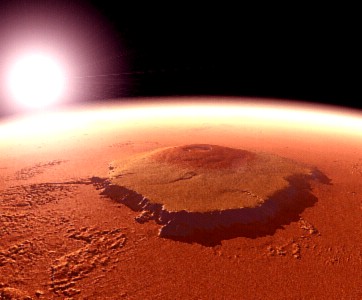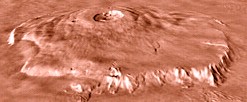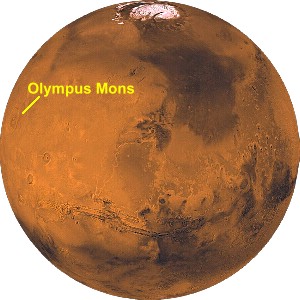  Olympus Mons is the biggest mountain on Mars. It is also the biggest mountain so far discovered anywhere in the solar system. It rises about 25 kilometres above the surrounding surface; its actual height is closer to 27 kilometres, since it stands in a 2 km deep depression. Its height is about three times that of Mount Everest. Its base is more than 550 km in diameter and it is surrounded by a cliff 6 km tall.
Olympus Mons is the biggest mountain on Mars. It is also the biggest mountain so far discovered anywhere in the solar system. It rises about 25 kilometres above the surrounding surface; its actual height is closer to 27 kilometres, since it stands in a 2 km deep depression. Its height is about three times that of Mount Everest. Its base is more than 550 km in diameter and it is surrounded by a cliff 6 km tall.Measurements of Olympus Mons are only estimations; they were calculated by examining the pictures taken by the spacecraft Mariner 9 in 1971. Olympus Mons is an extinct ‘shield’ volcano. It was formed the same way that the Hawaiian Islands were formed ... by an eruption of magma from a 'hot spot' below the surface. The huge size of Olympus Mons reflects the fact that Mars does not have moving tectonic plates; the crust remains fixed in place, and the lava discharge has continued in one spot for a long time.  If Martian volcanoes like Olympus Mons were active over a very long time period, a large amount of gas would have been released into Mars' atmosphere. In the past, Mars must have had a thicker, warmer atmosphere. When volcanoes were active, the planet could have been warm enough for liquid water. Evidence that water once flowed can be seen on the surface of Mars today in the form of what appear to be dry river and lake beds. If Martian volcanoes like Olympus Mons were active over a very long time period, a large amount of gas would have been released into Mars' atmosphere. In the past, Mars must have had a thicker, warmer atmosphere. When volcanoes were active, the planet could have been warm enough for liquid water. Evidence that water once flowed can be seen on the surface of Mars today in the form of what appear to be dry river and lake beds.
 Olympus Mons has a central caldera that is 85 kilometres wide; inside it are multiple overlapping craters created by different volcanic events. As a result of lava flowing out of its volcanic vents over a long period of time, Olympus Mons is much wider than it is tall; the average slope of its flanks is very small.
Olympus Mons has a central caldera that is 85 kilometres wide; inside it are multiple overlapping craters created by different volcanic events. As a result of lava flowing out of its volcanic vents over a long period of time, Olympus Mons is much wider than it is tall; the average slope of its flanks is very small. Olympus Mons is so huge (roughly the size of the American state of Missouri) that a person standing on the surface of Mars would be unable to see the entire volcano even from a distance, as the curvature of Mars would hide much of it. The only way to view the mountain properly is from space. Click here to see a zoomable large photo of Olympus Mons. |